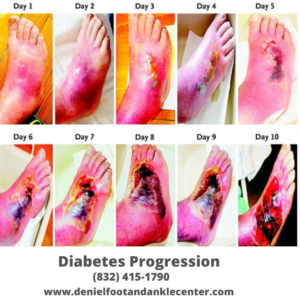 People with diabetes experience foot problems often and are always in fear of the unknown, the worst being one in the reality of losing a foot, leg, or toe. Managing diabetes or glucose levels will keep your feet healthy. Over time diabetic neuropathy or nerve damage that causes pain and tingling then leads to the loss of feeling in the feet. After losing the feeling a blister or cut on the foot may go unnoticed and it can lead to infections.
People with diabetes experience foot problems often and are always in fear of the unknown, the worst being one in the reality of losing a foot, leg, or toe. Managing diabetes or glucose levels will keep your feet healthy. Over time diabetic neuropathy or nerve damage that causes pain and tingling then leads to the loss of feeling in the feet. After losing the feeling a blister or cut on the foot may go unnoticed and it can lead to infections.
Diabetes lowers the amount of blood flowing to the feet making it hard for an injury, a diabetic foot ulcer, or blister to heal. An infection will not also heal fast. If the gangrene and foot ulcers do not get better, they can lead to amputation of a part of the foot or leg. Amputation is done to prevent the infection from spreading to the rest of the body. Diabetic foot care and wound care are crucial to prevent foot conditions that can escalate to serious issues. A diabetic patient can also experience a change in the shape of the feet due to nerve damage such as Charcot’s foot. It starts with warmth, redness, and swelling then the bones in the toes and feet can shift or break, causing an odd foot shape.
How to keep your feet healthy?
Diabetes of the feet can be difficult to control and live with. To learn more, contact our podiatrist Ejodamen Shobowale, DPM of DeNiel Foot and Ankle Center. Our doctor will assist you with all of your foot and ankle issues and get up and about on your feet in no time. Our health professional will help you with diabetic wound care, diabetic foot ulcer treatment, and diabetes self-care plan with an action plan to manage diabetes.
Tips when caring for your feet include
- Wash and check your feet every day.
Use warm soapy water to wash. Test the water with your elbow to test the warmth of the water then soak the feet, do not soak for long because the skin will get too dry. After washing, dry and use talcum powder or cornstarch between the toes to keep the skin dry. Check for any foot problems and use the mirror to check under the feet for any problems.
- Wear shoes and socks all the time.
Do not walk bare feet because you might step into something that will hurt your feet and you may not feel pain. Always check the inside of your shoes before you put them on. The socks or stockings keep the feet from getting blisters and sores.
- Smooth calluses and corns gently.
The thick patches of skin need to be smoothed out gently in one direction to avoid tearing the skin which can lead to foot ulcers.
- Trim the toenails straight.
Use toenail clippers to trim straight across and do not cut into the corners of the toenails. It will prevent the nails from growing into your skin causing damage.
- Keep the blood flowing to your feet.
Improve the blood flow to your feet by putting them up when seated. Wiggle your toes and move your ankles throughout the day. Avoid tight socks or stockings that will cut off blood flow to the feet. Choose easy activities for your feet.
- Have regular visits to the podiatrists.
Comments
[…] who has diabetes is aware of the significance of changing your diet. That entails eliminating unhealthy meals and […]